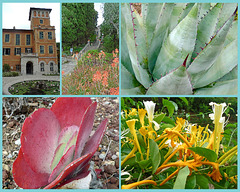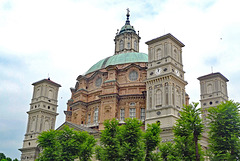
Italia - Italy - Italië
Italy - Riomaggiore
| |
|
|
|
The Cinque Terre is a string of five old fishing villages perched high on the rugged coastline of the east end of the Italian Riviera in Liguria. Until recently they were linked only by mule tracks and accessible only by rail or water. Nowadays Cinque Terre is a UNESCO Heritage Site. It's also one of the most sought-after travel destinations in all of Italy. The five villages are no longer the isolated hamlets they once were, but there’s still a feeling of authenticity, with few roads and perfectly preserved architecture.
Riomaggiore - the most eastern village of Cinque Terre is the largest of the five and acts more or less as its unofficial ‘headquarters’. The charming village is perched on a terraced hillside and its pastel coloured tower-houses march down to a tiny harbour.
The village was originally founded in the 8th century by Greek refugees anxious to take advantage of the naturally rich soil and plentiful sea life surrounding it. Nowadays Riomaggiore however, actually dates back to the 13th century and was named for the stream, Rivus Major, that flows underneath today’s main road “Via Cristoforo Colombo. Only in the nineteenth century the village was reached by the railway, which first connected it to the other villages of the Cinque Terre and then to the rest of Italy.
We visited the villages of Cinque Terre from our 'base' Levanto with the "Carta 5 Terre Treno". This card allows unlimited travel by train for one day in the Cinque Terre region.
Italia - Tolmezzo, Duomo di San Martino
| |
|
|
|
The Cathedral of Saint Martin ( Duomo di San Martino ) is the city’s most important religious building. The current building dates back to 1764 and stands along the main square of the town - Piazza XX Settembre - on the site of the ancient church of San Martino, which was demolished to make way for the new church designed by Domenico Schiavi from Tolmezzo. The facade was completed only in 1931.
The interior of the cathedral is well-proportioned with side chapels and a high altar of white marble . The ceiling has three frescoes, dating back to 1764. The side altars are adorned with beautiful 18th century paintings.
On the main picture you see the tomb of Saint Hilary (Sant’Ilario), patron Saint of Carnia (a mountain area in Friuli-Venezia Giulia). Every year in August (usually the first Sunday after 15th August the mortal remains of the Saint, will be moved to the little chapel of "Sant'Ilario and Madonna della Strada" outside the center of Tolmezzo. For the entire period in which it remains, usually three days, every evening the holy rosary is recited. After that period, the mortal remains will be move again at the Cathedral with a religious procession and remain exposed for a few days. So we were quite lucky to come across this tomb.
Italy - Riomaggiore, San Giovanni Battista
| |
|
|
|
The Chiesa San Giovanni Battista is the parish church of Riomaggiore . The church was founded in the year of 1340, as stated in the plaque situated on the southern side of the building. The church is located in the upper part of the village, it was built during a period of economic development.
In 1870, following a collapse, a reconstruction of the neo-gothic style façade and an extension of the entire building were carried out, maintaining, however, the 14th century rosette in white Carrara marble. The two gothic style entrances and the single-lancet windows are remaining evidences of the original structure.
The church has a basilica plan and three naves separated by elegant pointed arches. It offers several pieces of art, among them a wooden crucifix, a 15th century triptych depicting the Virgin with Child and saints Rocco and Sebastiano and a valuable marble pulpit.
Italy - San Remo, Chiesa di Cristo Salvatore
| |
|
|
|
Chiesa di Cristo Salvatore (Church of Christ the Saviour) is an Russian orthodox church, dating back to the year 1915. It was built for the Russian community that followed Tsarina Maria Aleksandrovna (wife of Tsar Alexander II) to San Remo in 1906; the foundation stone was laid in 1912. In that period about one thousand Russians lived in the town.
The Chiesa di Cristo Salvatore - with its onion domes and heavenly pale-blue interior - was designed by Alexei Shchusev, later finished by local engineer Pietro Agosti. Icons and murals of Christian saints line the interior. The appearance of the temple imitates the style of typical 17th-century Moscow churches. It has five domes, three altars and a belfry.
The church is still used today by the Orthodox community of San Remo and is one of the landmarks of San Remo.
Italy - Sella Group
| |
|
|
|
The Sella Group (Gruppo del Sella, Sellagruppe) is a plateau-shaped mountain massif in the Dolomites. It is located in Northern Italy on the border of Trentino-Alto Adige (Trentino-Südtirol) and Veneto. South of the Sella lies the Marmolada Group with the highest mountain of the Dolomites. To the west one has a view of the Lang- and Plattkofel (PiP 4). The highest peak of the Sella Group is the Piz Boè at 3.151 meters above sea level.
My pictures were taken at the Pordoi Pass, with an altitude of 2.239 meters, connecting the villages of Arabba with Canazei. From the pass starts a cable car to the Sass Pordoi (2.950 m).
Italy - Varigotti
| |
|
|
|
Varigotti - once a fishing village and nowadays a seaside resort, is characterized by bright coloured houseswith their ‘feet’ in the sand. Due to its beaches the villages is a popular tourist destination. Varigotti is also known as “Saracen hamlet”.
Varigotti has experienced varied dominations over the centuries. In late antiquity times, it was known as Varicottis. In 643, when it was home to a Byzantine fortification, it was destroyed by the Lombard king Rothari. Later it suffered from Saracen raids, and in the 12th century it was contended between the marquisses of Noli and the Del Carretto family. Later it was a possession of the Republic of Genoa, and became an autonomous commune after the French Revolution.
Once an independent municipality, in 1927 it became part of Finale Ligure.
Italy - Ventimiglia, Hanbury Botanical Gardens
| |
|
|
|
The Hanbury Botanical Gardens (Giardini Botanici Hanbury) have their origin in 1867, when Thomas Hanbury bought the ancient Palazzo Orengo and the adjacent pieces of land, in order to transform them into a garden of exotic plants. Half of the gardens are cultivated with (sub)tropical plants; the other half is occupied by a Mediterranean self-vegetation. In the garden one can discover for instance agaves, aloes, succulent plants, cactuses and citrus and exotic fruits trees.
After some years the garden was well-known because of its richness in plants and the importance of its collection. The Hanbury Botanical Gardens extends on a surface of 18 hectares, nearby the frontier between Italy and France. In 1960 the garden - which was seriously damaged during World War II - was sold to the Italian state. In 1987 the management of the garden was entrusted to the University of Genua. In 2001 the Hanbury Botanical Gardens became also a nature reserve.
We had read many positive reviews about the gardens, but honestly, we were quite disappointed. It made a rather 'withered' impression on us.
Italy - Verbania Pallanza, Villa Taranto
| |
|
|
|
In the 19th century Lake Maggiore was discovered by English travelers, who built beautiful summer residences along the lake; among others also the well-known Villa Taranto with 16 hectares of gardens. The botanical gardens surrounding the Villa Taranto were created between 1931 and 1940 by the Scottish captain Neil McEacharn. He bought an existing villa and its neighboring estates, cut down more than 2.000 trees, and undertook substantial changes to the landscape, including the addition of major water features.
Today the gardens contain nearly 20.000 plant varieties, representing more than 3.000 species, set among 7 km of paths. With some 150.000 visitors yearly it is the biggest tourist attraction in the area.
Italy - Vernazza
| |
|
|
|
The Cinque Terre is a string of five old fishing villages perched high on the rugged coastline of the east end of the Italian Riviera in Liguria. Until recently they were linked only by mule tracks and accessible only by rail or water. Nowadays Cinque Terre is a UNESCO Heritage Site. It's also one of the most sought-after travel destinations in all of Italy. The five villages are no longer the isolated hamlets they once were, but there’s still a feeling of authenticity, with few roads and perfectly preserved architecture.
Vernazza is the only village of the famous Cinque Terre (Five Villages) to be included in the list of borghi più belli d'Italia (most beautiful villages of Italy). It is the most prosperous village of the Cinque Terre, partly due to the somewhat larger harbour, guarded by a watch tower, which was once part of the impressive Castello Doria.
Vernazza has a long history: the village was probably founded around the year 1000. It was ruled by the Republic of Genoa starting in 1276. One of the families that helped to found Vernazza is said to have given its name to the village: the Gens Vulnetia. Vernazza is said to be a corruption of this family name.
The church Santa Margherita d'Antiochia, which was built in 1318, lies directly on the village square and harbour. The octagonal, 40-meters bell tower rises proudly, like a lighthouse for the colourful fishing boats.
We were exploring Cinque Terre by train. Believe it or not, when we got out of Vernazza station we came across of Dutch acquaintances from our home town among the thousands and thousands of tourists.
Italy - Vicoforte, Basilica della Natività di Mari…
| |
|
|
|
The Basilica della Natività di Maria Santissima (Basilica of the Nativity of Maria Santissima), commonly called “Sanctuary of Vicoforte” is one of the most important churches in Piedmont.
The huge complex has its origins in a medieval sanctuary. The story tells that an errant shot by a hunter in the year of 1592 hit a pillar of the Virgin Mary in a shrine that happened to be very important to pilgrims, and he was so repentant that he put down his gun and raised money for the repair of the pillar.
In a few years the place became a destination for increasingly frequent pilgrimages. In 1596 Duke Carlo Emanuele I of Savoy who, in 1596, commissioned the construction of a large sanctuary, but was never finished. It was not until 1728 when construction was resumed by architect and engineer Filippo Juvarra. Above the Mannerist sandstone base, the drum was quickly built, and the dome, which was finished in 1732.
The basilica has - with more than 6.000 square meters - the largest elliptical cupola in the world, which has major and minor diameters of 36 and 25 meters. The fresco decorations were completed in 1752.
During our visit to Vicoforte, the basilica was closed. Unfortunately, we could only see (and photograph) the dome through a gate.
Jump to top
RSS feed- Latest items - Subscribe to the latest items added to this album
- ipernity © 2007-2024
- Help & Contact
|
Club news
|
About ipernity
|
History |
ipernity Club & Prices |
Guide of good conduct
Donate | Group guidelines | Privacy policy | Terms of use | Statutes | In memoria -
Facebook
Twitter










